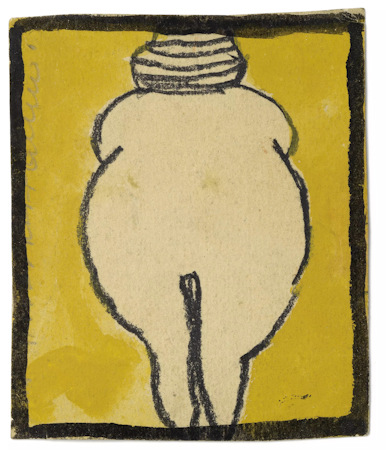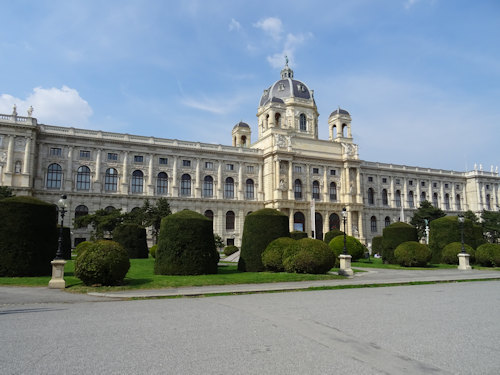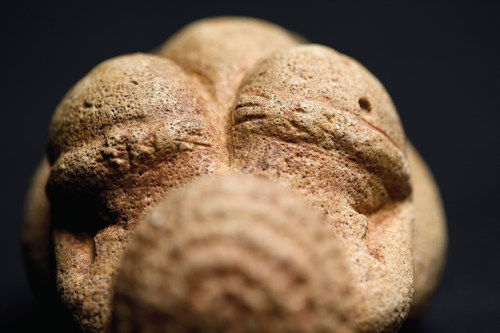
Forget your Mona Lisas and Arnolfini Portraits. Vienna has an artistic treasure that predates these newcomers by around 29,000 years: the Venus von Willendorf.
- Ancient paleolithic limestone figurine
- On permanent display in the Natural History Museum’s prehistory section
- See also:
- NHM visitor & ticket info
- Top art exhibits in Vienna
Paleolithic perfection
(Press photo courtesy of and © Naturhistorisches Museum Wien)
Vienna’s Natural History Museum (Naturhistorisches Museum or NHM) has an architecture and history almost as impressive as its contents. It’s also a research hub as much as a museum.
Nevertheless, your average visitor drops in for the extensive public galleries. You might want to see the huge meteorite collection or maybe the special exhibitions catch your eye.
But almost everything inside pales in comparison with the fame and importance of one small unassuming item on display: the Venus von Willendorf statuette.
The name stems from the type of figurine and the place of discovery.
Archaeologists found the Venus figure (a description which does not imply any connection to the goddess of the same name) while excavating near the village of Willendorf in 1908.
Hence Venus of Willendorf.
At first sight, our limestone woman seems a little unspectacular. Just a small, voluptuous female body, a touch more than 11cm high, and with no distinguishable facial features.
If you made the Venus in pottery class, you’d shrug and move on. And nobody knows for sure quite what its purpose was.
Initial impressions were of some kind of fertility or sex symbol, but today’s scientists give that interpretation little credence.

(The statue has inspired other creators. For example, the above picture is a draft design for a wall decoration by the acclaimed artist Egon Schiele from 1918; Wien Museum Inv.-Nr. 240458; excerpt reproduced under the terms of the CC BY 4.0 license; photo by Birgit and Peter Kainz, Wien Museum)
It’s the context that’s important with this particular figurine, though. For she is old.
Very old.
Around 29,500 years old, in fact.
And so you are confronted by one of the world’s oldest statues of a complete human figure.
To give you an idea of just how old that is, consider that when some paleolithic human took a tool to the piece of oolite limestone that became this Venus…
- Mammoths would still wander Europe for another 18,000+ years
- The wheel was still some 23,000 years away from being invented
- The first pyramid would not appear for around 25,000 years
We do know the stone used for the Venus did not come from the dig area. Research published in 2022 revealed that the most likely origin is near Lake Garda in modern-day Italy, though Ukraine is another plausible option.
Remarkably, the Venus of Willendorf is not even the oldest figurine of its kind ever found in Austria. She has a less-famous, but older, neighbour: the “Fanny” figure (the Venus of Galgenberg) in an adjacent display cabinet dates back around 36,000 years.
Nevertheless, if you want an even earlier Venus figurine from Europe then you have to travel across the border to Germany. The Urgeschichtliches Museum Blaubeuren has the Venus of Hohle Fels, estimated to be some 40,000 years old and possibly the oldest female statue in existence.
How to get to the Venus statue

(View of the museum on the Marie-Theresien-Platz square)
The Natural History Museum is one of Vienna’s iconic Ringstrassen buildings from the great construction period of the late 19th century. It faces its twin, the Kunsthistorisches Museum, while the Hofburg Palace complex begins on just the other side of the road.
So, to cut a long story short, it’s right in the centre. See here for tips on reaching the museum.
Once inside the NHM, head for the prehistory (“Urgeschichte”) section on the lower floor. The small gallery housing the Venus von Willendorf leads off to one side from Gallery 11.
Incidentally, another astonishing piece of artwork lives on that same floor.
Trace your steps back to Gallery 4 for the gemstone bouquet given to Emperor Franz Stephan by his wife, Empress Maria Theresa, sometime around 1760. If you counted one diamond per second, you’d still be counting half an hour later.
Address: Burgring 7, 1010 Vienna
